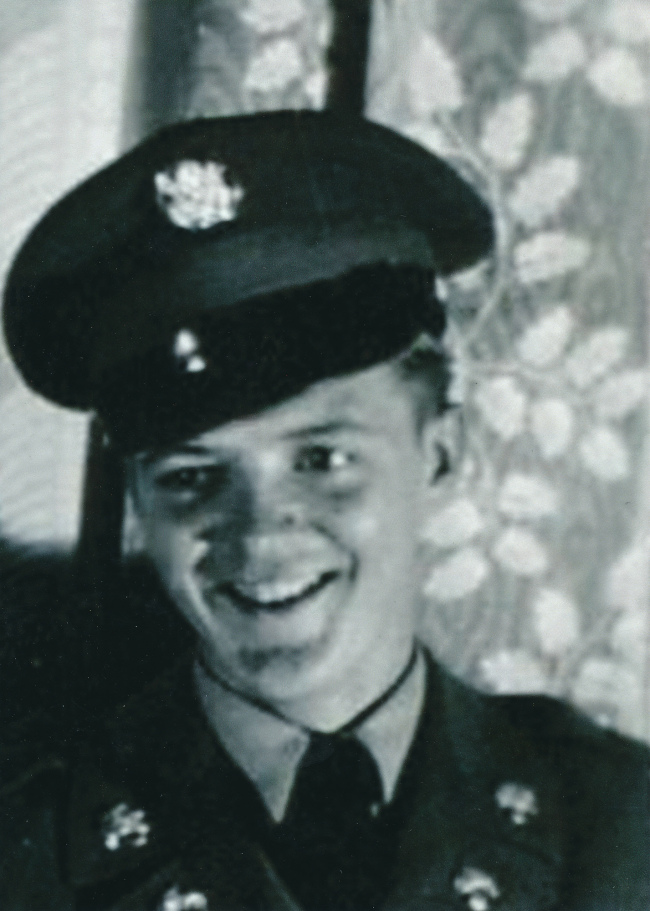Decades later, Korean War MIA’s remains back in N.Y.
By Korea HeraldPublished : Nov. 10, 2013 - 19:01

ALBANY, New York (AP) ― More than 60 years after a teenage soldier disappeared during a fierce Korean War battle, the DNA provided by one of his siblings has led to his remains being identified and returned to his upstate New York hometown for burial.
A plane carrying the casket with George J. Conklin Jr.’s remains arrived Wednesday at the Rochester airport, where it was met by a military honor guard, family members and Patriot Guard motorcycle riders. A hearse then took the casket east to Conklin’s hometown of Phelps, a rural Finger Lakes village of about 2,000 residents.
Over the last few miles, the route was lined with veterans, firefighters and residents paying tribute to Conklin. When the motorcade reached Cheney Funeral Home in Phelps, it was greeted by hundreds of people who fell silent as his casket was removed from the hearse.
“It was a phenomenal sight,” said funeral home owner Peter Cheney. “It was amazingly silent. It was like a peace come over everybody.”
Conklin was 17 when he went into the Army in 1949. He was a private first-class serving in the 7th Infantry Division’s 31st Regimental Combat Team as it supported encircled U.S. Marines fighting their way out of the mountainous terrain near North Korea’s Chosin Reservoir in early December 1950, when temperatures dipped far below freezing. Conklin was among a large contingent of American soldiers overrun by Chinese forces. He was reported missing, then listed as killed in action when the war ended in 1953.
His father died in 1991 and his mother three years later without knowing how he died or where he was buried. Conklin had two younger brothers: Ken, who died in 2009, and Carl, who died in April.
Nearly a decade ago, Carl gave a DNA sample to the Joint POW/MIA Accounting Command, the Pentagon unit charged with finding and identifying missing U.S. military personnel recovered from overseas battlefields. In September 2004, a JPAC team recovered human remains and military material evidence at two sites near the Chosin Reservoir. Pentagon officials said Conklin’s remains were identified in September at JPAC’s laboratory in Hawaii through the DNA sample.
The news was greeted with happiness tinged with sadness that his brothers didn’t live long enough see his remains returned to Phelps, said Karen DesCamp, Carl Conklin’s daughter.
“Everybody was very happy and, of course, wishing it could have been years earlier,” she said.
Conklin is one of several 31st Regimental Combat Team soldiers whose remains were recovered in 2004 and identified in recent years.
Conklin, who was promoted posthumously to corporal, will be buried next to his parents during a graveside service with full military honors Saturday morning at Resthaven Cemetery in Phelps.
A plane carrying the casket with George J. Conklin Jr.’s remains arrived Wednesday at the Rochester airport, where it was met by a military honor guard, family members and Patriot Guard motorcycle riders. A hearse then took the casket east to Conklin’s hometown of Phelps, a rural Finger Lakes village of about 2,000 residents.
Over the last few miles, the route was lined with veterans, firefighters and residents paying tribute to Conklin. When the motorcade reached Cheney Funeral Home in Phelps, it was greeted by hundreds of people who fell silent as his casket was removed from the hearse.
“It was a phenomenal sight,” said funeral home owner Peter Cheney. “It was amazingly silent. It was like a peace come over everybody.”
Conklin was 17 when he went into the Army in 1949. He was a private first-class serving in the 7th Infantry Division’s 31st Regimental Combat Team as it supported encircled U.S. Marines fighting their way out of the mountainous terrain near North Korea’s Chosin Reservoir in early December 1950, when temperatures dipped far below freezing. Conklin was among a large contingent of American soldiers overrun by Chinese forces. He was reported missing, then listed as killed in action when the war ended in 1953.
His father died in 1991 and his mother three years later without knowing how he died or where he was buried. Conklin had two younger brothers: Ken, who died in 2009, and Carl, who died in April.
Nearly a decade ago, Carl gave a DNA sample to the Joint POW/MIA Accounting Command, the Pentagon unit charged with finding and identifying missing U.S. military personnel recovered from overseas battlefields. In September 2004, a JPAC team recovered human remains and military material evidence at two sites near the Chosin Reservoir. Pentagon officials said Conklin’s remains were identified in September at JPAC’s laboratory in Hawaii through the DNA sample.
The news was greeted with happiness tinged with sadness that his brothers didn’t live long enough see his remains returned to Phelps, said Karen DesCamp, Carl Conklin’s daughter.
“Everybody was very happy and, of course, wishing it could have been years earlier,” she said.
Conklin is one of several 31st Regimental Combat Team soldiers whose remains were recovered in 2004 and identified in recent years.
Conklin, who was promoted posthumously to corporal, will be buried next to his parents during a graveside service with full military honors Saturday morning at Resthaven Cemetery in Phelps.
-
Articles by Korea Herald


![[AtoZ into Korean mind] Humor in Korea: Navigating the line between what's funny and not](http://res.heraldm.com/phpwas/restmb_idxmake.php?idx=644&simg=/content/image/2024/04/22/20240422050642_0.jpg&u=)
![[Exclusive] Korean military set to ban iPhones over 'security' concerns](http://res.heraldm.com/phpwas/restmb_idxmake.php?idx=644&simg=/content/image/2024/04/23/20240423050599_0.jpg&u=20240423183955)



![[Graphic News] 77% of young Koreans still financially dependent](http://res.heraldm.com/phpwas/restmb_idxmake.php?idx=644&simg=/content/image/2024/04/22/20240422050762_0.gif&u=)

![[Herald Interview] Why Toss invited hackers to penetrate its system](http://res.heraldm.com/phpwas/restmb_idxmake.php?idx=644&simg=/content/image/2024/04/22/20240422050569_0.jpg&u=20240422150649)





![[Exclusive] Korean military to ban iPhones over security issues](http://res.heraldm.com/phpwas/restmb_idxmake.php?idx=652&simg=/content/image/2024/04/23/20240423050599_0.jpg&u=20240423183955)



![[Today’s K-pop] Ateez confirms US tour details](http://res.heraldm.com/phpwas/restmb_idxmake.php?idx=642&simg=/content/image/2024/04/23/20240423050700_0.jpg&u=)